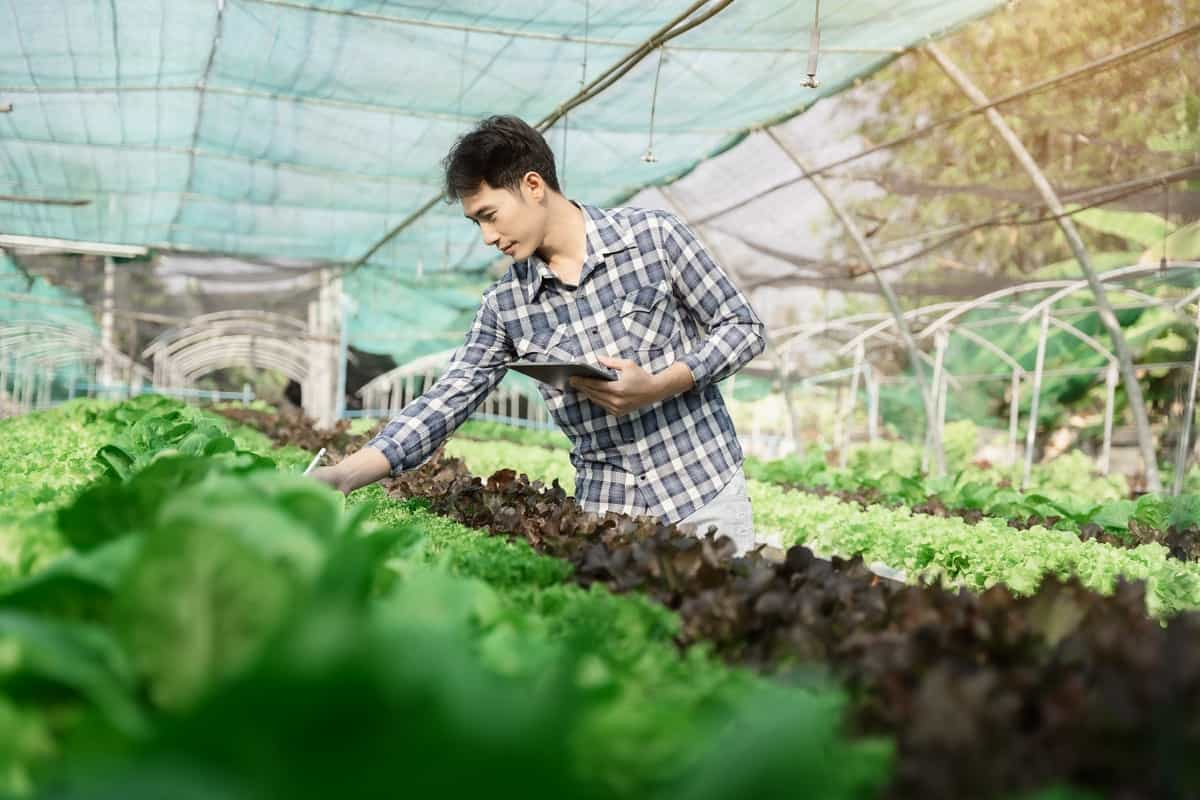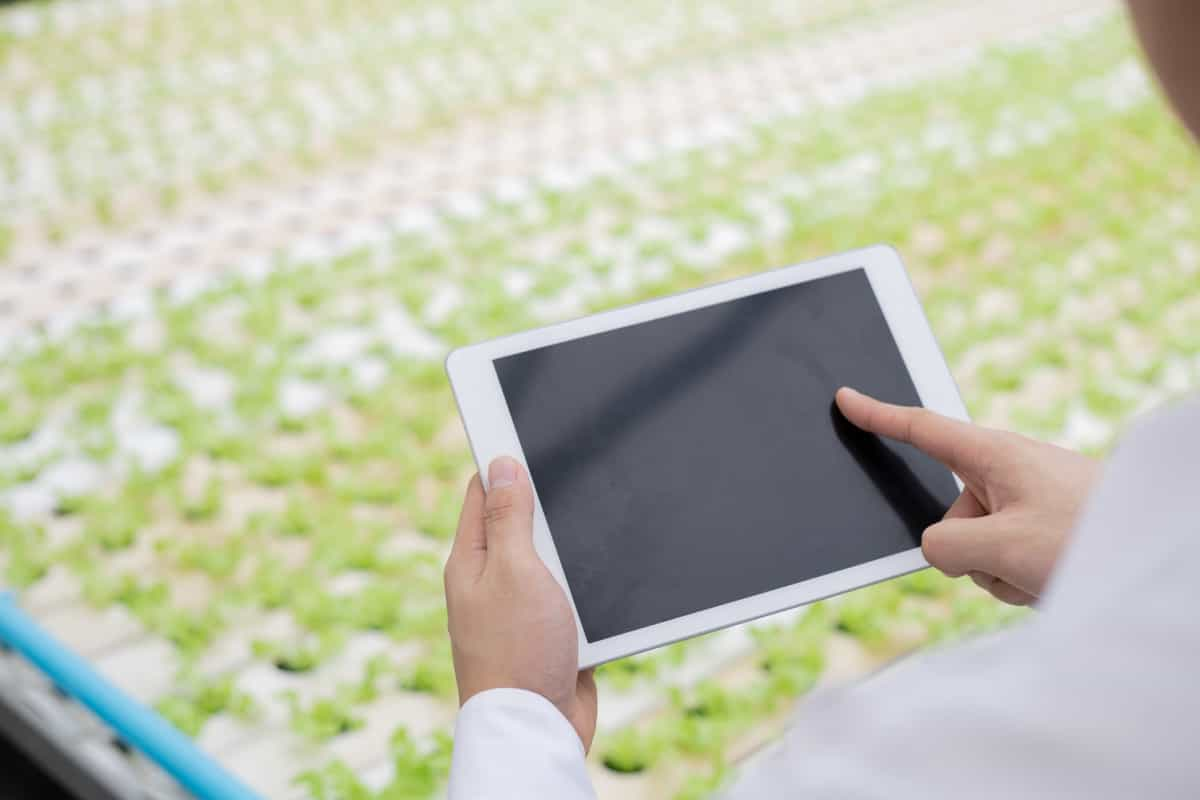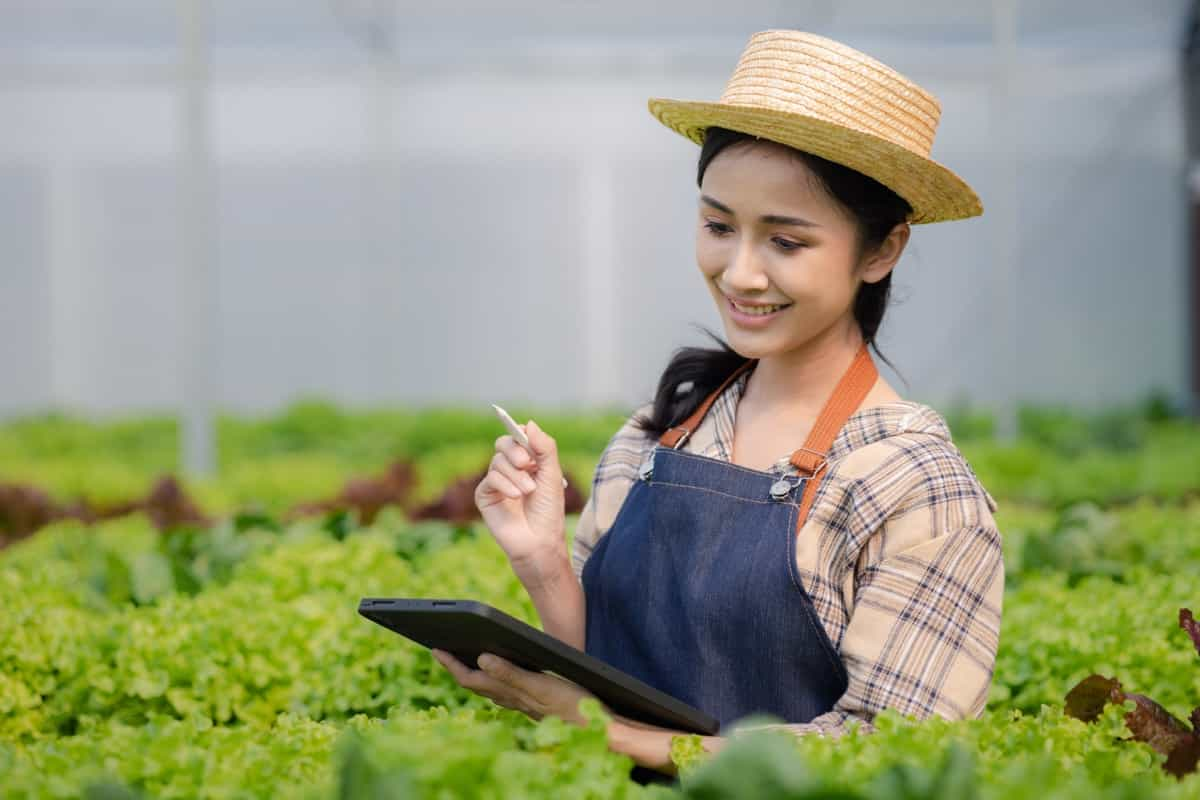IoT, or the Internet of Things, is defined as a network of interconnected devices communicating and sharing data. When applied to hydroponic farming systems, ioT enables farmers to control various aspects of their operations in real time. Farmers can gather valuable information about temperature levels, humidity, pH balances, nutrient concentrations, and more through IoT sensors and data collection.

Hydroponic Farming Using IoT
Benefits of Implementing IoT in Hydroponic Farming Systems
Implementing Internet of Things (IoT) technology in hydroponic farming systems brings many benefits that revolutionize crops’ growth. The advantage is the ability to remotely monitor and control various aspects of the farm, resulting in enhanced efficiency and productivity. IoT lets Farmers access real-time data on crucial parameters such as temperature, humidity, pH levels, nutrient concentrations, and even plant growth patterns.
Additionally, automation plays a key role in optimizing hydroponic farming with IoT. Automated systems can accurately manage tasks like nutrient delivery and irrigation schedules without human intervention. This saves time and ensures consistent and optimal conditions for plant growth throughout the cultivation cycle.
Another benefit of IoT in hydroponics is predictive analytics combined with machine learning algorithms. By analyzing historical data collected from previous growing seasons and current sensor readings, AI-powered systems can forecast future trends and provide actionable recommendations for maximizing yield potential while minimizing resource waste.
How IoT Enhances Efficiency and Productivity in Hydroponic Farming
IoT allows real-time monitoring of various parameters essential for plant growth, such as temperature, humidity, pH levels, nutrient concentration, and light intensity. This continuous monitoring ensures that plants receive optimal conditions at all times. Automation plays a crucial role in enhancing efficiency in hydroponic farming using IoT.
Farmers can precisely control water flow rates and nutrient delivery schedules based on specific crop requirements through automated systems like smart irrigation controllers and nutrient dosing pumps connected to the internet. Farmers can make informed decisions regarding planting schedules, harvesting timelines, or even adjusting lighting conditions during different growth stages by analyzing historical data collected from various sensors within the farm environment and external factors like weather forecasts or market demand trends.
In case you missed it: Smart Farming in Greenhouse: How to Start Using IoT Automate and Optimize the Growing Process

Furthermore, Sensors are deployed across the farm, providing real-time environmental information that helps farmers gain valuable insights about their crops’ health status. This leads to early detection of diseases or pest infestations, ultimately resulting in timely intervention strategies, thus improving overall crop yield.
The Role of Sensors and Data Collection in IoT-based Hydroponic Farming
Sensors play an important role in monitoring various parameters within the system, providing real-time information that can be used for analysis and optimization. Sensors measure important variables such as temperature, humidity, pH, nutrient, and light intensity. They continuously gather data from different farm parts, allowing farmers to comprehensively understand their crops’ needs.
Data collection is equally important as it enables farmers to track trends. By analyzing historical data patterns, they can identify problems early on and take preventive measures before they escalate. Furthermore, integrating sensors with cloud-based platforms allows farmers to access real-time information remotely.
Automation and Control Systems in IoT-enabled Hydroponic Farms
With IoT-enabled control systems, farmers can precisely monitor and adjust nutrient levels based on real-time data from sensors placed throughout the farm. Furthermore, automation allows precise control over environmental factors such as temperature, humidity, and lighting. These parameters can be continuously monitored and adjusted remotely, if necessary, through IoT connectivity.
This saves time and minimizes human error in maintaining ideal growing conditions. In addition to automating basic tasks like irrigation and lighting schedules, advanced control systems can utilize machine knowledge algorithms to analyze data collected from multiple sources. These algorithms can then predict crop health or identify issues before they become significant problems.
Monitoring and Optimization of Nutrient Delivery in Hydroponic Systems Using IoT
It is crucial in hydroponic systems to ensure healthy plant growth and maximize yields. With the integration of IoT technology, this process has become more efficient and effective than ever before. IoT enables real-time monitoring of various parameters such as pH levels, nutrient concentrations, temperature, and humidity within the hydroponic system.
In case you missed it: Integrated Pest Management in Hydroponics: IPM Strategies for Pest Control in Hydroponic Farming

The data collected from these sensors can be analyzed using advanced analytics algorithms powered by machine learning techniques. This analysis helps identify patterns, trends, and correlations that may not be easily detectable. Furthermore, IoT also facilitates remote access and control over nutrient delivery systems through mobile devices or computers connected to an internet connection.
Real-time Environmental Monitoring for Improved Crop Growth in IoT-based Hydroponics
This real-time monitoring allows growers to make immediate adjustments to optimize crop growth. For example, if the temperature rises too high or drops too low, automated systems can be triggered to adjust the climate controls accordingly. If nutrient levels are off balance or pH levels are not within range, alerts can be sent directly to farmers’ smartphones so that corrective action can be taken promptly.
It enables farmers to always provide optimal growing conditions for their crops. This leads to healthier plants with faster growth rates and higher yields. Data analysis helps prevent potential issues such as pests or diseases by identifying early warning signs. In addition to providing precise control over environmental parameters like temperature and humidity, IoT-enabled sensory networks also play a crucial role in water management.
Predictive Analytics and Machine Learning in IoT-driven Hydroponic Farming
The benefit of predictive analytics in IoT-driven hydroponics is its ability to forecast future trends and patterns. By analyzing historical data collected from sensors placed throughout the farm, algorithms can identify correlations between variables such as temperature, humidity, nutrient levels, and plant growth.
Machine learning takes it further by continuously improving predictions based on new data inputs. As more information is gathered over time, the algorithms become more accurate at anticipating potential issues or opportunities for improvement within the hydroponic system. This enables proactive measures to be taken before problems arise, or adjustments are made to maximize yield.
Integration of IoT with Vertical Farming Techniques for Sustainable Agriculture
The advantage of combining IoT with vertical farming techniques is the ability to monitor and control various environmental factors affecting plant growth closely. Sensors installed throughout the vertical farm collect real-time data on temperature, humidity, light intensity, and nutrient levels.
This data is then analyzed to make informed decisions about adjusting conditions for optimal crop growth. IoT-enabled vertical farms also enable remote monitoring and control, allowing farmers to access critical information from anywhere at any time. Integrating IoT with vertical farming techniques holds immense promise for sustainable agriculture.
Challenges Implementing IoT in Hydroponic Farming
The main challenge is the initial cost of setting up an IoT-based system. The sensors, control systems, and data collection devices can be expensive. Another challenge is ensuring reliable connectivity between all the components of the system. Maintaining a stable internet connection in remote or large-scale farms can be difficult. Without a robust network infrastructure, the entire IoT framework may collapse.
Additionally, integrating different technologies and software platforms can prove to be complex. Compatibility issues between hardware and software components can arise, leading to delays and inefficiencies. Training farm workers to operate and maintain an IoT-driven hydroponic system poses challenges. Providing comprehensive training programs and ongoing technical support is crucial for successful implementation.
Frequently Asked Questions about Hydroponic Farming Using IoT
Can IoT Help with Pest Management in Hydroponics?
Yes. With IoT devices like smart cameras and motion sensors coupled with machine learning algorithms, farmers can detect pests or diseases early on. These systems alert growers when any abnormal activity is detected so that prompt action can be taken to prevent further damage.
In case you missed it: Essential Hydroponic Farming Equipment for Starting Plants in Hydroponics

Does Using IoT Increase Yields in Hydroponic Farms?
Yes. By closely monitoring environmental variables like light intensity and carbon dioxide levels through connected devices, farmers can create optimal conditions for plant growth. This leads to higher yields than traditional methods, where these factors may fluctuate more unpredictably.
How Does Monitoring Work in Hydroponic Farming Using IoT?
Monitoring involves gathering real-time data from various sensors placed throughout the growing system, measuring parameters like temperature, humidity, pH level, electrical conductivity (EC), dissolved oxygen content (DO), and more. Farmers can make informed decisions about optimal plant health and growth adjustments.
Can Automation Be Achieved with IoT in Hydroponics?
Absolutely. With IoT integration, tasks like adjusting lighting schedules or triggering irrigation cycles can be automated based on predetermined parameters set by the farmer.
Conclusion
Hydroponic farming using IoT is a method of cultivating plants without the need for traditional soil-based systems. Instead, it relies on water enriched with essential nutrients to nourish the plants. Hydroponic farming using IoT is important in revolutionizing traditional agricultural practices. By implementing IoT in hydroponics, farmers can greatly enhance efficiency and productivity.
- Feed Your Flock for Less: Top 10 Tips to Save on Chicken Feed
- Ultimate Guide to Ossabaw Island Hog: Breeding, Raising, Diet, and Care
- Hatching Answers: The Top 10 Reasons Your Chickens Aren’t Laying Eggs
- Eggs and Economics: Breaking Down the Cost of Raising Backyard Chickens
- Defend Your Greens: Proven Methods to Keep Iguanas Out of Your Garden
- Ultimate Guide to Cinnamon Queen Chicken: A Comprehensive Guide for Beginners
- Ultimate Guide to California Tan Chicken: Breeding, Raising, Diet, Egg-Production and Care
- Ultimate Guide to Marsh Daisy Chicken: Breeding, Raising, Diet, and Care
- 10 Types of Chicken Farming Businesses You Can Start for Profits